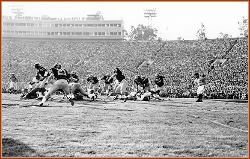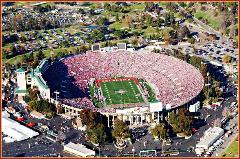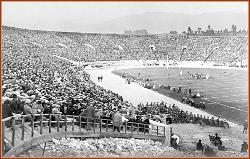Memorial Stadium Capacity
1923: 31,000, original stadium, with stands on both sides,
modeled after Ohio Stadium
1964: 48,000, south end zone bleachers erected, making
stadium a horseshoe
1965: 53,000, center section of north end zone bleachers
erected.
1966: 65,000, the rest of the north stadium bleachers finished.
1967: 65,000, New Press Box
1972: 73,650, south end zone bleachers extended
1994: 72,700, reduced capacity for handicapped seating, Husker
vision installed
1999: 74,056, new press box that included new skyboxes, and
club seating.
2000: 73,918, reduced capacity for more club seating.
2006: 81,067, new skyboxes for north stadium and bleachers
extended again, new video boards.
Nebraska Cornhuskers' Memorial Stadium
The home of the Huskers since 1923 and the location of a continuing NCAA-record
sellout streak that reached 282 games at the conclusion of 2006, Memorial Stadium
has undergone some dramatic changes this season.
More than 6,500 seats have been added in the North Stadium as part of the Memorial
Stadium Expansion Project, which will bring the historic stadium's capacity to 81,067 in
2006. The impressive changes, including one of the largest in-stadium replay screens
in the nation - have been evident on gameday in 2006.
As part of the expansion, Memorial Stadium will gain a glorious new North end with the
addition of the Osborne Athletic Complex. The cutting edge project not only includes a
new home for Nebraska football, as the coaches' offices and player locker room will
move from the South Stadium to the North Stadium, it will also include the Charles and
Romona Myers Performance Center. The new performance area will provide every
one of Nebraska's nearly 600 student-athletes all the elements to maximize their
performance, including a new strength complex, athletic medicine center, hydrotherapy
pools, and nutrition center, all on one level.
The Memorial Stadium Expansion Project also includes the new Hawks Championship
Center, which is opened for use by the Nebraska football team this spring. The Hawks
Championship Center, which features a 120-yard field with an identical FieldTurf
surface to the gameday surface inside Memorial Stadium, gave the Huskers a second
indoor practice area across the outdoor grass practice fields from Cook Pavilion. The
Hawks Championship Center is connected by a skybridge to the Osborne Athletic
Complex.
While the Osborne Athletic Complex will house Nebraska's administrative offices, the
inside of Memorial Stadium also gains a a massive HuskerVision screen and
scoreboard in the North end zone, along with several luxury suites.
In all, the $50 million project provides a better practice and gameday atmosphere for
student-athletes and fans at Memorial Stadium for years to come.
Nebraska's continuing NCAA record of consecutive home sellouts passed the
200-mark in 1994 and will reach 282 with seven home sellouts in 2006. On
Homecoming, Oct. 29, 1994, against the University of Colorado, Nebraska celebrated
its 200th consecutive sellout.
Nebraska's 2006 contest against Missouri set a single-game attendance mark of
85,197, bettering the 85,187 fans on hand against Texas on Oct. 21, 2006.
In 2001, Nebraska set a single-season home attendance record by totaling 622,436
fans for the second-best average home attendance in school history with 77,804 fans
per game, trailing only the 77,878 fans per game in 2000.
The streak of consecutive sellouts started on Nov. 3, 1962, when 36,501 attended the
Homecoming contest against Missouri. The last non-sellout came Oct. 20, 1962, when
the Huskers and Kansas State drew 30,701.
With renovations for the 2000 season, Memorial Stadium's capacity was reduced by
113 seats to 73,918, which was down from the 74,031-seat capacity in 1999 but up
from the 72,700 in 1998. Home attendance has averaged more than 75,000 fans per
game for the past 31 years, as NU has ranked among the nation's attendance leaders
for many years.
In the fall of 1922, a drive for $430,000 in stadium construction funds was undertaken
by faculty, students, alumni and friends of the University of Nebraska. The quota was
over subscribed. The stadium was named Memorial Stadium to honor all Nebraskans
who served in the Civil and Spanish-American Wars; the 751 Nebraskans who died in
World War I; the 3,839 in World War II; the 225 in Korea; and the 422 in Vietnam.
Construction was completed in a few more than 90 working days and Memorial Stadium
was dedicated on Oct. 20, 1923, at the Homecoming game in which Nebraska was held
to a scoreless tie by Kansas.
Inscribed on the four corners of the stadium are the following words, written by former
UNL professor of philosophy Hartley Burr Alexander:
Southeast: "In Commemoration of the men of Nebraska who served and fell in the
Nations Wars."
Southwest: "Not the victory but the action; Not the goal but the game; In the deed the
glory."
Northwest: "Courage; Generosity; Fairness; Honor; In these are the true awards of
manly sport."
Northeast: "Their Lives they held their countrys trust; They kept its faith; They died its
heroes."
As part of the continuing improvement of athletic facilities at the University of Nebraska,
several major projects have been completed throughout the past 80 years enhancing
the facility. The $1 million Hewit Center dining/study hall area was opened in March of
1985, underneath the West Stadium adjacent to the massive strength complex. The
weight room and the Hewit Center were expanded and remodeled in 1989.
Prior to the fall of 1994, Nebraska installed two 17 feet high, by 23 feet wide replay
boards, now known to Nebraska faithful as HuskerVision screens.
Following the 1997 season, construction began on a $36-million improvement project
which was completed during the 1999 season. Included in the improvements are the
addition of the Don Bryant Media Facility and 42 skyboxes, each of which house 25
spectators on game day. In addition, club seating rose from approximately 350 to 1,500
per game. The improvement project also tripled the number of restrooms on both the
East and West sides of the stadium, doubled the number of concessions in both East
and West concourses and included concrete repair and waterproofing throughout the
stadium. The 1999 season also saw the introduction of FieldTurf as the playing surface
at Memorial Stadium. The renovations raised the capacity of Memorial Stadium from
72,700 to 73,918. It is also noted that the original four inscriptions remained visible for
generations to come.
Top 10 Season Averages
No. Year # of Games Total Attendance Avg.
1. 2000 6 467,269 77,878
2. 2001 8 622,436 77,804
3. 2002 8 622,415 77,802
4. 2003 7 544,276 77,754
5. 1999 6 466,375 77,729
6. 2004 6 466,152 77,692
7. 2005 7 542,397 77,485
8. 1988 6 458,050 76,342
9. 1974 7 534,388 76,341
10. 1983 6 458,005 76,334








